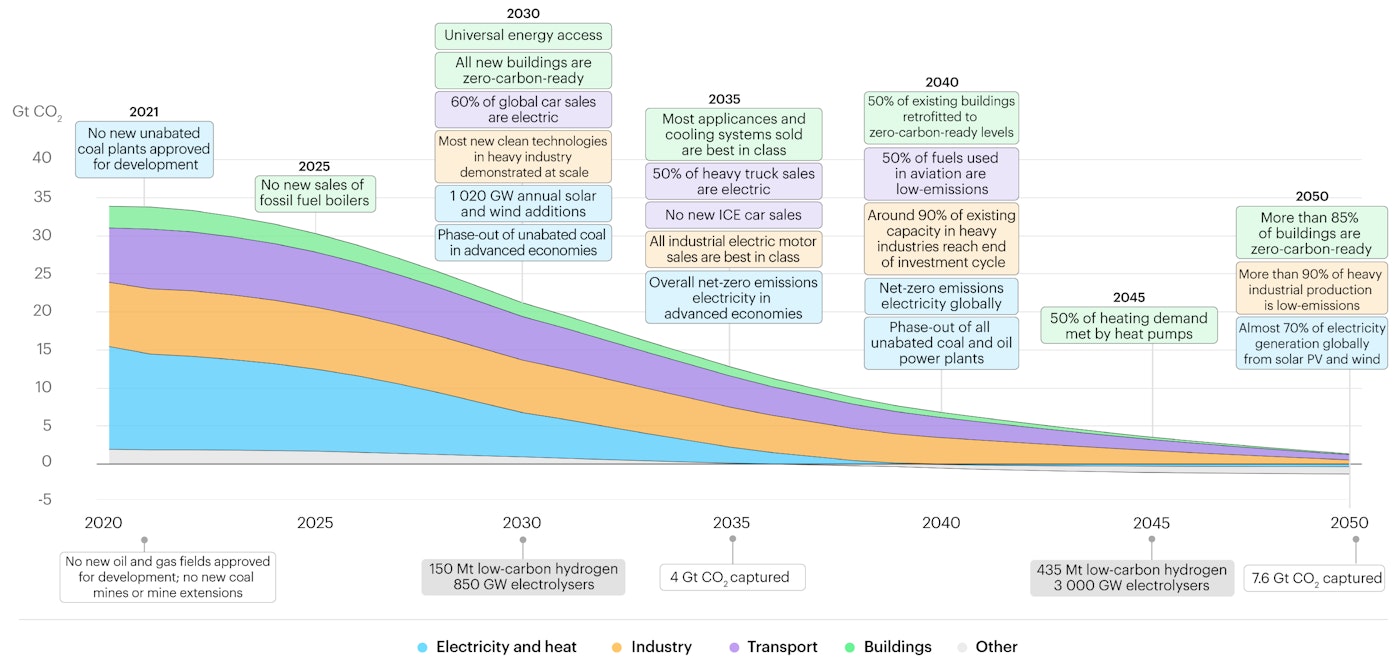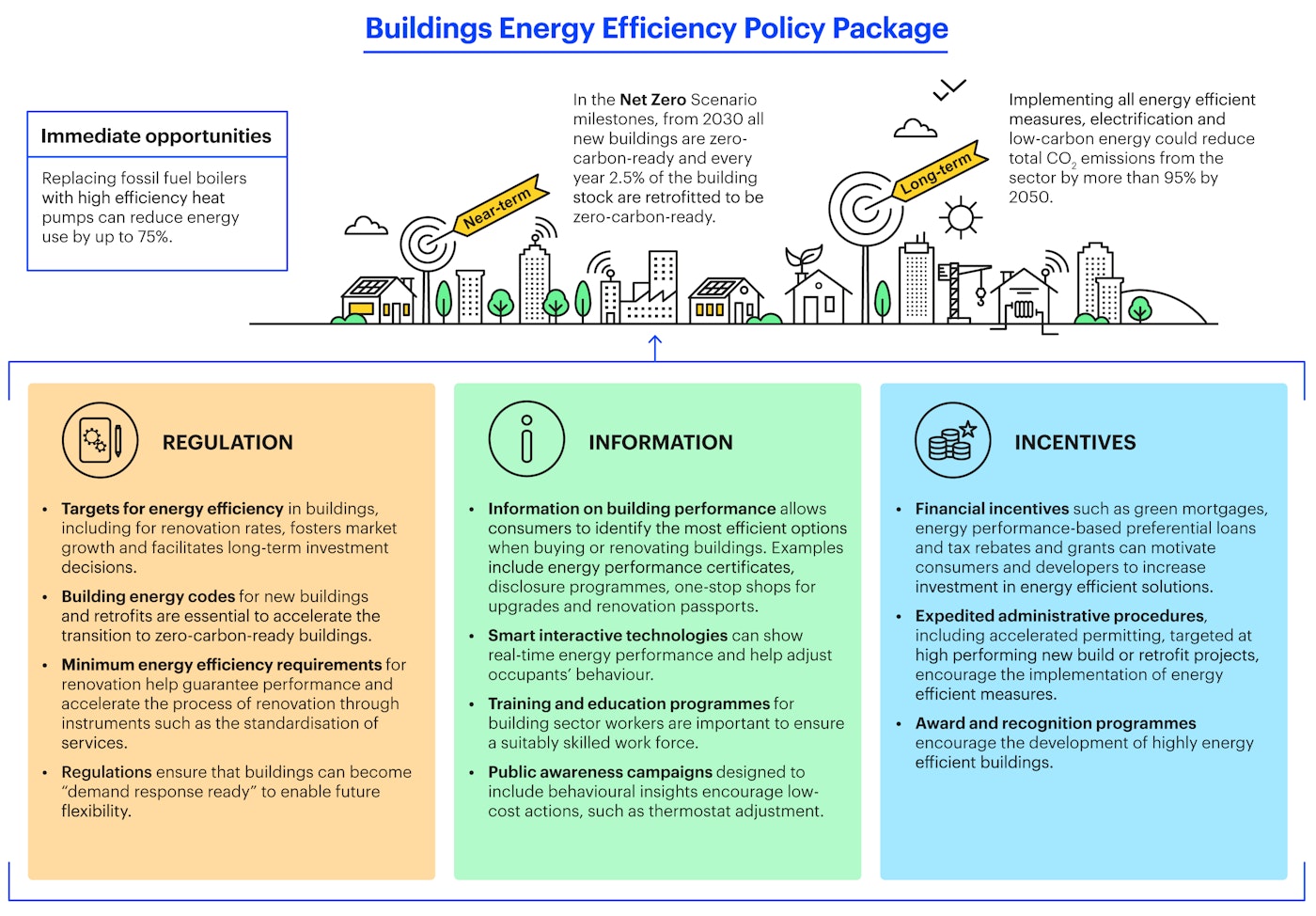Cite commentary
IEA (2023), The energy efficiency policy package: key catalyst for building decarbonisation and climate action, IEA, Paris https://www.iea.org/commentaries/the-energy-efficiency-policy-package-key-catalyst-for-building-decarbonisation-and-climate-action, Licence: CC BY 4.0
This article was originally published on ArchDaily.
Driving Climate Change Action: The Crucial Role of Buildings and Construction Sectors
The buildings and construction sectors are key players in the fight against climate change –Combined, they are responsible for 30% of global final energy consumption and 27% of total energy sector CO2 emissions. Further, energy demand from buildings and construction continues to rise, driven by improved access to energy in developing countries, growing need for air conditioning, greater ownership and use of energy-consuming appliances, and a rapid growth in global floor area. Without targeted policy actions, the energy used in buildings could increase up to around 70% in 2050.
IEA Net Zero Scenario: Unveiling the Building Sector's Energy Efficiency Role
Energy efficiency measures in buildings are a cornerstone for achieving global carbon reduction targets and UN Sustainable Development Goals. In the IEA Net Zero Scenario –a scenario that shows a narrow yet achievable pathway for the global energy sector to achieve net zero CO2 emissions by 2050– carbon emissions from buildings more than halve by 2030. Achieving this requires significant efforts to reduce energy demand through clean and efficient solutions. Key milestones to achieve the Net Zero Scenario by 2030 are improved building envelopes that reduce thermal energy needs; the shift to best available appliances, lamps, and air conditioners; more efficient and clean technologies, such as heat pumps and district energy; and increased flexibility. Also, replacing traditional use of solid biomass (such as wood or charcoal for cooking) with more efficient and cleaner alternatives could help to achieve universal access to clean cooking by 2030, while achieving universal energy access by 2030 – in line with Sustainable Development Goal 7.
Milestones to the IEA Net Zero Pathway by 2050
Open
Unlocking the full benefits of energy efficiency measures in buildings
The benefits of improving energy efficiency in buildings go well beyond energy savings and emissions reduction – it also lowers energy bills, generates additional skilled long-term jobs in buildings construction, improves indoor and outdoor air quality, and advances energy system security and resilience through load management. Given that people spend on average 90% of their time indoors, ensuring that buildings are comfortable and healthy for the occupants can help achieve an overall improvement of people’s health and avoid further detrimental impacts on the vulnerable groups. By accounting for these benefits, policy makers can integrate energy efficiency into a range of policy areas that can support multiple economic and societal goals.
Unleashing the Potential: the Crucial Role of the Energy Efficiency Policy Package
To support stronger government action on building efficiency the IEA has designed the Buildings Energy Efficiency Policy Package which has been widely used in many regions and countries around the world. This Policy Package provides a practical approach to accelerating action on energy efficiency in the buildings sector by guiding governments in the design and implementation of effective policy measures and activities. It is built on the foundation of three essential elements of policy: Regulation, Information, and Incentives – When developed together as a coherent and complementary set, these three elements make for a highly effective instrument for improving the efficiency of buildings over time.
Regulatory policy instruments are critical elements of a Policy Package, with building energy codes being among the most widely recognised, scalable and effective policy instruments for buildings. They are implemented in over 80 countries around the world, and a further 31 are actively developing them. There are two common approaches to designing building energy codes: a more prevalent “prescriptive” strategy, and a less common but increasingly used “performance-based” option. Prescriptive codes typically set minimum specifications on a component-by-component basis; they are often preferred by builders, designers, and other practitioners because they provide direct, explicit requirements which can be demonstrated in a relatively straightforward manner. However, prescriptive codes are not inherently flexible, and do not allow trade-offs between, say, more insulation to allow for more windows. As a result, many countries are adding performance-based compliance options for a growing number of building types, allowing the market to achieve high efficiency with the method that works best in each case. For instance, California’s building energy codes aim to reduce energy consumption for new buildings by 80 percent.
In addition to improving building envelopes, regulations that increase the efficiency of appliances and equipment within them are also a key piece of the puzzle. Mandatory minimum energy performance standards (MEPS) and labels for key appliances and equipment used in buildings have proved to be incredibly effective. MEPS and labels have helped more than halve the energy consumption of major appliances in countries with the longest-running programmes. While it is important that new MEPS are adopted in a wider range of countries, particularly emerging and developing regions, it is also crucial that countries in which they already exist expand the number of products and end-uses covered and continue to increase the ambition of regulation over time. By doing so, manufacturers are given the important long-term signals needed to encourage investment in the latest, most efficient technologies.
Once regulation is in place, their effective implementation and enforcement should be supported by informational policy instruments, as well as incentives to ensure compliance and further progress. In terms of information, building certification and labelling with ratings based on energy and carbon performance can provide clear signals for consumers and industry to encourage more informed and sustainable choices and practices. Likewise, capacity-building programmes are crucial to ensuring that there are sufficient skills and knowledge to deliver efficiency improvements in buildings at sufficient pace, develop effective efficiency policies and ensure their enforcement and compliance. One example of such a programme, the IEA's Energy Efficiency Policy Training Weeks, brings together policy-makers from across emerging economies to explore ways to implement effective policies across key sectors, including buildings. These events help build capacity and foster government-to-government collaboration when it comes to energy efficiency policy design and implementation. In Mexico, the NAMA for Sustainable Housing (an initiative under the UNFCCC Framework), provides training to federal and local officials to promote energy efficiency in social housing.
As the third pillar of the Energy Efficiency Policy Package, incentives are a critical complement to regulation and information policy instruments. Incentives can be financial (e.g., grants, preferential loans, and tax rebates) or other form of incentives (e.g., expedited development review and approvals, fee reductions and density bonuses), and are often linked to building energy performance certification schemes. They are intended to stimulate the adoption of regulations and help overcome market barriers such as high upfront costs and limited access to capital and drive action beyond minimum standards. For instance, Frederikshavn in Denmark developed specific soft loans for the energy renovation of housing to meet its climate change targets. A new product was created by the municipality in agreement with local banks, with a longer maturity period and lower interest rates than other market products. In Chile, the Ministry of Housing and Urbanism implemented a subsidy programme for insulation of low-income housing. From 2009-12, nearly 33 000 families benefitted from the programme. Likewise, SEFA provided a USD 1 million grant to the Kenya Power and Lighting Company to create its Super ESCO. Projects focus on the rehabilitation of building, renovation of electrical air conditioning and heating systems and implementation of new efficient.
45 governments endorse the goal of doubling global energy efficiency progress by 2030 along with the Policy Package approach
At the IEA's recent 8th Annual Global Conference on Energy Efficiency in June, 45 governments from around the world endorsed a goal of doubling the average global rate of energy efficiency improvements by the end of the decade, to foster economic growth and put the world on the path towards Net Zero emissions. This is an ambitious but critical goal. Achieving it demands that governments rapidly turn up the dial on ambition, in every sector - but particularly in buildings. The IEA's policy packages provide a guide for exactly how to do that.
Driving Effective Implementation: The Link Between Ambitious Policies and Achieving the Building Sector Transformation
While developing ambitious policies is important, it is only half of the picture. Effective implementation – ensuring that policies are enacted in a way that achieves their desired outcomes – is a critical and often overlooked part of the picture. Actions must be taken in a way that builds on the domestic context and supports a more holistic approach within institutional structures and policy frameworks. The IEA Policy Package is a tool that can be used by national governments and supporting agencies when designing policies and support actions to accelerate the transition of their buildings sector towards net zero-carbon goals.
Catalysing Action to Unleash the Untapped Efficiency Potential of the Building Sector
While a lot of progress has been made, with building codes being part of the policy framework in more than 80 countries, carbon emissions from buildings need to more than halve by 2030 to align with the IEA Net Zero Scenario. Unlocking the enormous untapped efficiency potential of the buildings sector demands a concerted action by governments and the private sector. These efforts should include a combination of regulation, information, and incentives to ensure their effectiveness.

The energy efficiency policy package: key catalyst for building decarbonisation and climate action